Naomi Osaka out-Serenas Serena. Novak Djokovic remains unbeaten in Melbourne. Takeaways from the 2021 Australian Open
Out of the 14-day soft tennis quarantine, we are cleaning out the notebook and notes app. Here are 50 Thoughts from the 2021 Australian Open. First, we did this last major and it got a lot of response. So we’ll offer again: if you want The Mailbag newsletter style, sent every Wednesday as an email, let me know.
• You thought Novak Djokovic was flexible? How about the contortions pulled off by Tennis Australia required simply to hold this event. And by the rest of the community to adjust accordingly? Hard and soft quarantines. Nasal swaps for all. Crowds and no crowds and crowds again. No linespeople. Simultaneous tournaments. Tennis players are creatures of habit and routine; yet there were daily variables mocking the best laid plans. Nevertheless, they persisted. We’ll see where the sport goes from here. But a prolonged racket-claps. To Craig Tiley and team for getting this event staged. And to the players for the overall quality of play.
• All hail Novak Djokovic, your men’s singles champion who moved to 9-0 when he reaches the Australian Open final....and more important, moves to 18 majors. It was an adventuresome campaign. Sometimes Djokovic was extraordinary. Sometimes Djokovic simply kept his level while everyone else dropped theirs. As the great ones do, he saved his best for last. And the GOAT rodeo continues…
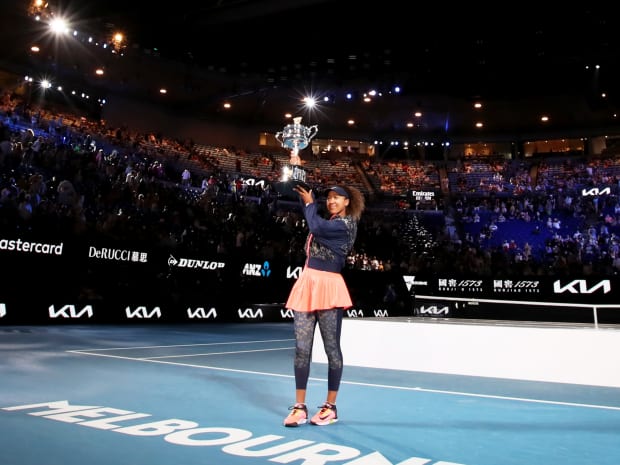
• Naomi Osaka, the women’s singles winner, has now taken the title at four of the last eight majors she has entered. (Quirk: one in 2018, 2019, 2020 and now 2021.) She’s now won 21 straight matches. Casual fans will see the unremarkable final scoreline. Fans who followed this tournament know her journey entailed beating tricky players (Ons Jabeur), staving off match points (Garbine Muguruza), destroying a sentimental/cult favorite (Hsieh Su-Wei), and out-Serena-ing Serena. Be assured the rest of the field followed the tournament.
• At the 2019 U.S. Open, Daniil Medvedev acquitted himself well and played valiantly against Rafael Nadal in the final. He left with a smile. Not so much in Melbourne. For six rounds—including straight set wins over Andrey Rublev and Stefanos Tsitsipas—Medvedev was brilliant. So much so, he was the oddsmakers' favorite to take the title over Djokovic. In the final, though, the Russian played both loose points and tight points and never quite found his best level, including on his serve. The opponent, of course, had a lot to do with that. But for a player who’d beaten Djokovic three times, including their most recent encounter, Medvedev didn’t have it in his second major final. And you suspect this makes for a bittersweet campaign. Still, Medvedev leaves with the No. 3 ranking. And the distinct impression he will majors. It would just help if the Big Three weren’t around.
• Jennifer Brady did not bring her best to Saturday’s final. But that shouldn’t overshadow her play for the previous six matches, nor her ascent since the tennis reset. Tennis’ answer to Taylor Swift, Brady was so productive in difficult 2020 and now the fruits: she currently ranked No. 13. And leaves with a sense that the best is still to come.
• Clearly emotional, Serena left her post-match press conference after her semifinal defeat, another (valiant) attempt at that 24th major thwarted by a younger opponent. Even when she wasn’t in a mood to speak, Serena revealed a great deal. (Note two words that didn’t leave her lips in her post-mortem: “Naomi” and “Osaka.” Insight into mindset of a champion, she believed she lost the match, not that it was won.) I have real empathy for Serena as, presumably, she now waits four long months for Wimbledon, her next, best chance at a major. She is no longer the force she once was. And yet she is still beating top players (Sabalenka, Halep here) and playing divinely, at least in spurts. She’ll make her own decision, of course, as she should. But in other sports, there are routes for winning championships in your late 30s. (Pick the right franchise. Downshift into a supporting role. Be Tom Brady.) In binary, individual sports, the pathway is less clear.
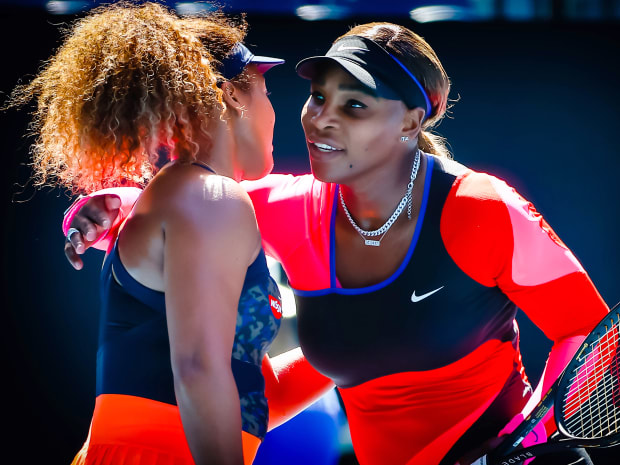
• Stefanos Tsitsipas scored perhaps the best win of his career, coming back from 0-2 sets to beat Rafa Nadal. And 48 hours later, he suffered perhaps the most gutting loss, a comprehensive defeat and the hands (and legs) of Medvedev. Not one for platitudes, Tsitsipas offered this withering self-assessment: “I just need to find a way to get there and just be in the same state of mind. I've proven that I have the level to beat these players. It's not that I haven't, but as Stan [Wawrinka's] says, ‘Ever tried, ever failed, no matter, try again... fail better.’ So let's hope for something better next time. I really hope it comes.” (For the record, he’s quoting Wawrinka’s tattoo quoting Samuel Beckett.)
• In the doubles, Elise Mertens and Aryna Sabalenka women’s title. They, of course, are both creditable singles players. In a men’s draw that generally lacked such creditable singles players as entrants—especially striking that this is an Olympic year—Ivan Dodig and Filip Polášek beat defending champs Rajeev Ram and Joe Salisbury to win the title. And Ram and Barbora Krejcikova took the mixed. (There were no junior matches in Melbourne.)
• Dominant champs, stunning upsets, taut finishes. Dylan Alcott leads the Wheelchair Honor Roll. (And good on Tennis Australia for making sure this was staged)
• In the quarters, Ash Barty was up 6-1, 2-1 on Karolina Muchova, cruising into another major semifinal. Muchova—not unpredictably—took a medical timeout because she had “lost her way.” And scene. Barty lost 12 of the next 15 games and Muchova prevailed 1-6, 6-3, 6-2. I’m of two minds here. Players should be penalized for these strategic breaks, that, at best, smudge the line between sportsmanship and gamesmanship. Players should also be penalized for failing to make adjustments for shifts in timing and tactics. Barty is likable and admirable on so many planes. But it was disappointing that the No. 1 seed was so addled and rattled that she allowed an opponent to turn a break into such a pivot point.
• The upset of the tournament? It may have been Rafa Nadal with a five-set loss to Stefanos Tsitsipas. Not a crazy result on paper. But it was given that a) Nadal ruled the head-to-head matchup and b) was leading 2-0 sets. Nadal has been to 13 Australian Open quarterfinals. He has won one title. Does he feel unlucky? “I never considered myself an unlucky person at all. It doesn't matter the injuries that I had. I think I am very lucky person. The only thing that I can do is just keep going.” That, friends, is a champion.
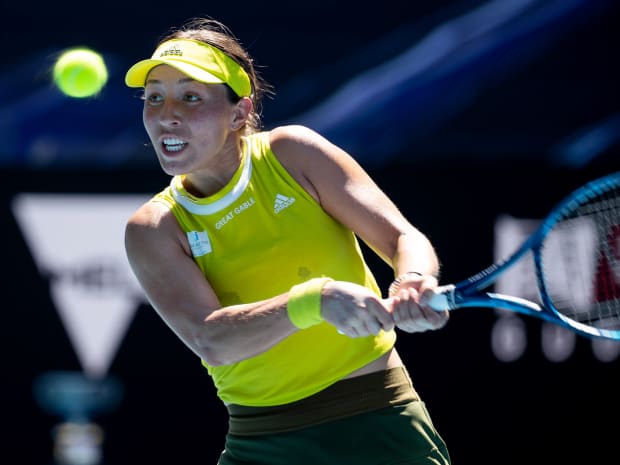
• A breakthrough event for Jessica Pegula, scoring her first top 10 win (Svitolina) and reaching the quarters before falling to her friend Jenn Brady. We should now be able to discuss her as a tennis player and person without a reference to her lineage or family net worth. Not unlike Brady—though under difference circumstances—there is something quietly admirable about a mid-career player saying, “I’m sick of being a middle manager and I want a promotion. I can’t go into the bosses’ office with a counter-offer. So I’ll promote myself, by making sacrifices.”
• I come to praise the Big Three—and Serena—and not bury everyone else. But you watch, say, Dominic Thiem win the U.S. Open and then back it up by reaching the quarters in Paris and then the fourth round in Australia compromised by vague injury, and you think: “Tinge of disappointment, but reasonable results.” Then you look at how reliably the Big Three reach the latter rounds of big events and you realize their reliability and durability might, finally, be more impressive than their major count.
• If tennis were a streaming series—which, of course, it is—Hsieh Su-wei would play the scene-stealing role. An easy-to-like game, with all that quirk and those staccato strokes. And an easy-to-like personality. Her coach Paul McNamee (whom we sometimes forget ran this event) dropped the anecdote of the tournament.
• One of the revelations of the event was, of course, Aslan Karatsev. (Because Russia needs another player in ascent.) The 27-year-old qualified and reached the semis. His career winnings for a decade on Tour in coming to Australia: $618,000. He made more than $650,000 for winning five matches in Melbourne. More important, he’s now in the top 50. “No more qualifying,” he noted.
• Different players, different ages, different circumstances, different issues. But there’s still considerable overlap between Felix Auger-Aliassime and Aryna Sabalenka—the two seeds to reach the fourth round who had never made a Grand Slam quarter. In his case, was up 2-0 sets on Karatsev and retreated. She had Serena on the ropes and retreated. Both are indisputably talented and future stars. But there’s undeniable scar tissue accumulating.
• One of the truisms of this past year: “COVID has accelerated trends that were already afoot.” Add to this, the elimination of tennis officials to technology and automatic line-calling. While acknowledging that there are real human beings impacted by this, it’s hard to resist the improved price and accuracy of automation. Fine. But how does tennis then not turn around and use that technology when it comes to data? If we are going to phase out linespeople—as it appears we are—can we at least transfer that capital and those jobs to improving the sport’s data? As @mattracquet put it nicely on twitter: “If this sport spent even 1% of the energy it devotes to mostly pointless mental gymnastics about shortening tennis’ formats on pricing strategy, content/streaming availability, participation diversity, zoomer player pr training etc etc we’d currently be living in a tennis utopia”
• The 2021 Australian Open prize money was redistributed—big ovation…in fact, a standing ovation for Novak Djokovic—to increase for the early rounds and decrease for the latter rounds. Some offset came from the currency markets. The Aussie dollar. At this writing, it’s $.78 US., up from $.67 from a year ago.
• A big winner at this event: Coco Gauff. She fell in round two in a tight, high-quality match to No. 5 Elina Svitolina. But won twice. She breezed to a first-round win. And she beat her double-fault-itis. She also reached the quarters in doubles with Caty McNally. We say it again: Gauff is still only 16; she is extraordinarily self-possessed; and it is a disguised blessing that her progress as a pro is steady and not meteoric.
• I’m not sure what we learned from Nick Kyrgios, who still manages to overachieve and underperform, often within the same match. He is obscenely talented. He can play with anyone. If he trained with the intensity and dedication he played C.o.D., he would fare better in five sets. He can be likable. He can be dislikable. His shot-making is great. His decision-making is less great. This may as well be the scouting report from 2015. Has there ever been a more ringing example of, “It is what it is?”

• Bracketed together with Kyrgios—not just alphabetically and not just on the doubles court—what a nice tournament for Thanasi Kokkinakis. Finally healthy, the 24-year-old Aussie won a match and then challenged Tsitsipas. It was heartening to see him back. It was heartrending to consider how deprived he’s been over the last five years.
• There are few cardinal rules of sports journalism, but here are two: 1) don’t suggest to athletes when they should/shouldn’t retire 2) don’t suggest to athletes when they are/aren’t injured. Some players (See: Venus and also Grigor Dimitrov), pointedly, persisted through injuries. Other players (Casper Ruud) pointedly did not. Djokovic and Nadal both expressed concerns about their physical states; and then looked no worse for it. Unless there is striking evidence to the contrary, we ought to proceed on the assumption that athletes are singularly knowledgeable about their own bodies.
• You wish it didn’t take a global pandemic to get here.… But some really encouraging data about the surge in American tennis participation over the past year. Dan Wolken is on it—and asks a good question: can this somehow fertilize a player who will break the Andy Roddick drought? I would also ask: what is the USTA’s gameplan to sustain this growth and keep these new players engaged? The fundamental (existential?) challenge: how do we take the wildly successful and glamorous U.S. Open and amortize that over 52 weeks?
• We say it again: it’s amazing how much less you sweat when you have to get your own damn towels. (A number of you, including an esteemed coach, correctly remarked that the incessant toweling off is less about hygiene than about players finding a routine between points.) Add “ballkids-handling-effluvia-filled-linens” as another COVID casualty we hope does not return.
• Speaking of towels, Ash Barty won a tricky—and at times unsightly—match against her friend Daria Gavrilova…who cried into her towel, orbited the court collecting towels (I counted three) and then left the court crying into her new accumulation of towels. (Then—before undergoing surgery—she issued a winning post.) And new rule to players: once a match ends, you cannot grab your towel swag without first shaking the opponent’s hand.
• This happened the week before the tournament, but Sorana Cirstea’s request that the umpire dock HER OWN COACH with a violation is worth a re-up. During tournament three players were fined for coaching: Tsitsipas, Margarita Gasparyan and….Cirstea.
• Fabio Fognini is popular among his colleagues, which ought to count for something. He lost me when he suggested Wimbledon be bombed. (He was kidding! That’s what makes it funny, see.) Here, he beat countryman Salvatore Caruso 14-12 in a fifth-set breaker and, as they met at the net, said what every gracious winner says as they approach a defeated foe. “You have been f---ing lucky.” They then nearly came to blows.
• Larger point: how much berth do we give players—athletes? humans?— for jackass-ery conducted in “the heat of battle?” Usually we say “a lot.” Stress hormones make for a powerful substance. We all are prone to make bad decisions in “hot states.” There is a reason why PR types encourage their clients to cool off before making public statements. But does this leeway minimize the cool of players—not just Federer and Osaka, but say, Ann Li, to pick a name—who manage to win and lose with poise.
• This would be a good question on a probability test (that we would fail). There are 128 players who pick practice partners. What are the odds those partners would then face each other in a randomized draw the following week? Which is to say: there sure seemed to be a disproportionate number of matches pitting the quarantine practice partners against each other. Monfils/Emil Ruusuvuori…Muchova/Pliskova…Tsitsipas/Ymer.
• Here are five players who didn’t get out of week one but still impressed: Nina Stojanovic (who put up a fight against Serena), big Max Cressy (again), 17-year-old Carlos Alcaraz (as advertised), Ann Li and Anastasia Potapova.
• Jim Courier does a great job with courtside interviews. Sometimes these are rollicking fun. Sometimes they are excruciating, yet offer insight into the player. This one would be the latter. (“You’re looking comfortable [on the court] except for this interview, which is really awkward.”) Other interviews—conducted by folks other than Jim—really missed the mark. Injured players not being asked about injuries. Statements rather than questions. After the aforementioned Fognini match, he was, inexplicably, not asked about the near-fist fight that had occurred mere seconds earlier. No one is expecting—or wanting—hard hitting journalism here. But if the questioners pondered, “What would the folks watching at home like to know?” that would go a long way.
• We all know how easy it is to upload and download a photo. You have one of the hottest acts in tennis, whose rise has been chronicled the world over. He’s been referenced by Nadal. He’s been trending on social. Can we do better than this?
• As it is written: if you no longer have sponsors to ply you with patches, you don’t need sleeves on your shirt.
• During the Discount-Double-Czech match pitting Karolinas—Muchova and Pliskova—against each other, the latter was so upset by her play that, between sets, she smashed a racket in the tunnel. Though the infraction did not technically occur on the court, she was still sanctioned. It helped her. And then it didn’t. She went up 5-0 in the second set. And then lost the next seven games.
• The defending champ, Sonia Kenin, left in tears. Then she lost to an unranked player in the post-prom party Philip Island event. Then she underwent surgery for an appendix removal. In many cases—this is not limited to sports, much less tennis—we media types wrestle with boundaries between professional and personal. So we tread cautiously here. But Kenin is not in a good place. Her words, not ours. And, it’s pretty clear, she might benefit from hearing a different (or at least additional) voice. Parents know their children like no one else. That can also have a stunting impact on growth.
• A favorite story from this event: unranked Li Tu, a local junior tennis instructor. He fell in the first round to Feli Lopez (decidedly not local; and decidedly not a junior). But not before putting up a fight. Said Tu: “If I play my best I can beat half the draw.”
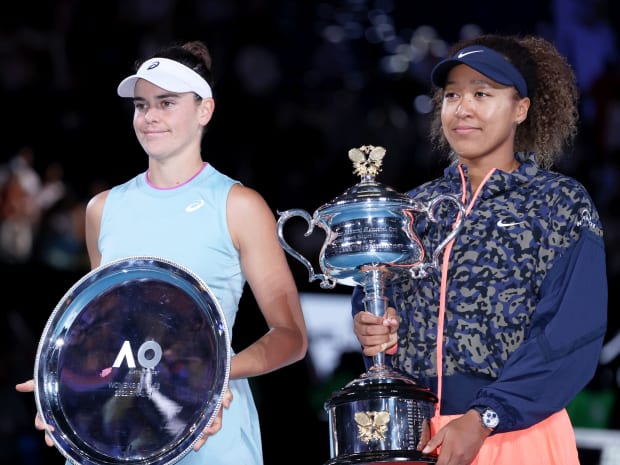
• A big winner at this tournament: UCLA tennis. Brady continued her tear. Mackie McDonald reached the middle weekend. Marcos Giron took a set off of Zverev. Cressy is establishing himself. And college tennis was all over the doubles draws. Not least Aliona Bolsova, a former Florida Atlantic player, and the most elaborately tattooed player in the draw….less happily this story about the LSU program is almost unspeakably horrific; and demands a meaningful response.
• The USTA and ITA (Intercollegiate Tennis Association) have engaged a consulting firm to help find ways to “protect” and “create long-term sustainability” for college tennis. I realize this sounds jingoistic but here’s an obvious one: get overseas recruitment under control. If I am an athletic director who has to find cost-savings and one program is made of instate kids—whose parents are taxpayers—and the other program’s roster looks like this, a hard decision just got a lot easier. A simple rule: the number of players on the tennis team roster must be within one order of magnitude of the school’s overseas student population overall.
• The annual pro forma item devoted to Margaret Court….I believe it was my new favorite tennis journalist, Matt Roberts—whom you should all follow—who raised an excellent point about naming venues. We don’t just go by raw records. Otherwise, Arthur Ashe—who won three career majors—would not be the eponym of the U.S. Open main stadium, as he, quite rightly, is. No, his name is embroidered on the joint at least in part because of what he represents. Thus, Tennis Australia’s contention that Margaret Court is being celebrated simply for her tennis—and let’s not pollute this with politics—is lazy and dishonest. Here’s the deal: she was a towering tennis champion. She has also revealed herself to be a vile bigot whose repeated public statements are deeply hurtful and offensive to many. This is a not “cancel culture,” someone making a bad choice and then being made to surrender their position. This is someone repeatedly making intolerant remarks and not being shielded from consequence. Tennis Australia hits a lot of clean winners, not least this year. But this is a bad error. It will look worse as time goes by. Some needles can’t be threaded. Guys, get some sleep. Then do the right thing.
• Murmurs from the USTA and beyond.…The two best Americans missed this event. John Isner, the highest ranked American, opted out and stayed home. The brightest prospect, Sebastian Korda, now 20, played events in Europe, winning in Quimper, France, shaving his ranking down to double digits. Big promise here.
• This isn’t unique to the Australian Open, but man, will we look back and laugh at the pumped in crowd noise. My favorite: the fake crowd noise mixed with giggling, often deployed at thoroughly unfunny moments. In the words of the prophets: “One likes to believe in the freedom of crowd noise /B ut glittering prizes and endless compromises / Shatter the illusion of integrity, yeah.”
• Credit to Heath Woodlief and his team for this piece we ran on Tennis Channel re: Kobe Bryant’s intersection with tennis. As always, it was good fun doing the pregame show with Martina and Steve Weissman.
• Before the event began, Tennis Australia announced that it would operate at a financial loss. But the loss would be worse if the event were cancelled and the momentum would atrophy. Then came five days with zero fans and, I’m told, that loss may have doubled. Those who benefitted in 2021—the players, coaches, media—ought to consider some sort of discount (a Tiley tithe?) in 2022?
• This has been a rough year for the good folks in Indian Wells. This year’s event was postponed—not, pointedly, cancelled…at least not yet—as there was hope that tennis’ two tours would make space on the calendar. (Not least because the CEO of one of the tours had a previous job…running Indian Wells.) Presented with a proposal to hold the tournament in October, both tours said, “Thanks, but, nah, we’re good.” The tours offered Indian Wells a December date, which wasn’t going to work, a) because no top players were going to come and b) that was too close to the 2022 tournament. So in all likelihood, the fifth major will go three years between vintages. Unless….
• Without compensation—or even acknowledgement—Australia did a great service to the global sports community. A lot of events watched closely to see how a large event dealt with athletes coming in from all over the world. I’m hearing from reliable and unbiased types that the Beijing Winter Games will use tennis’ China swing as a dry run for hosting international competition. But it’s possible China will say, “You know what? We have a 2022 Winter Olympics coming up. We can’t afford to have a mistake (and the attendant lousy PR) in the fall. We’re cancelling sports again.”….In which case, Indian Wells can swoop in and save the day.
• Anyone else watch the Netflix documentary on the fiercely proud and fiercely anti-establishment Nina Simone (a high recommend)…and then recoil upon hearing her song co-opted by that damn multivitamin commercial that aired on every changeover?
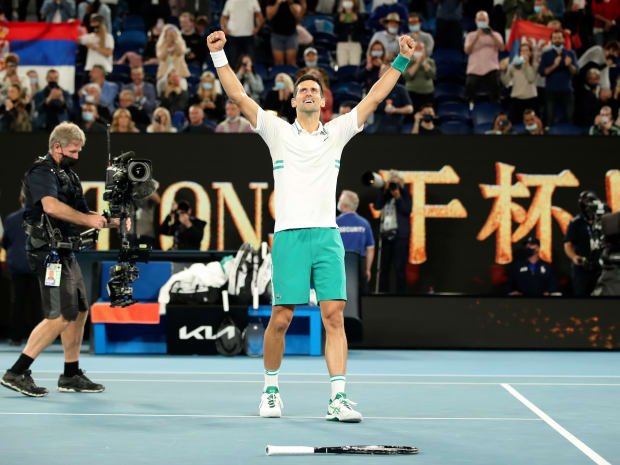
• Novak Djokovic raised this point and it’s a fair one: to what extent can the circuit continue to operate in 2021? There can be majors—with bubbles and pods and tens of millions in prize money up for grabs. But how can tennis continue to tour week-to-week? Especially when prize money has been slashed to account for the lack of attendance. Especially when different countries have different protocols and quarantine rules. Especially when a positive test can put a player in an uncertain position.
• A tip of the cap—with a spectacular head of hair poking out—to Tom Tebbutt, the dean of Canadian tennis writing, who has retired. At the (gulp) 1998 Canadian Open, at one of the first events I ever covered for Sports Illustrated, Tommy T. could not have been a more gracious host to the noob. And remained an extraordinary colleague ever since. There’s both a beauty and an irony to the fact that he’s retiring when Canadian tennis is at a pinnacle. Then again, he, too, goes out on top.
• There were only five former major champs on the men side. And two of them—Stan Wawrinka and the fading Marin Cilic departed early. As for the two absentees, Roger Federer will be back in Doha and has added Dubai—where he has a home—to his schedule. Andy Murray did not venture to Australia. Instead, he entered a Challenger in Biella, Italy; played 11 sets of tennis; reached the final (falling to Ilya Marchenko); and emerge with plenty of positive signs.
• Always fun geeking out on tennis with you guys. We’ll do it again in Paris. If you enjoyed the coverage, thank the bleary-eyed Jamie Lisanti. And favor her with a follow.